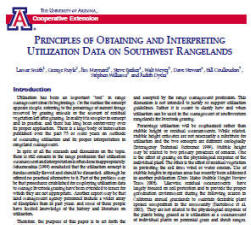|
Understanding and measuring Utilization
The Concept of Utilization
A really basic principle of biology is that solar energy can be captured by
plants and converted to chemical energy in the form of sugars, carbohydrates,
and fats. From the plant's perspective, this nearly magical act requires leaves
to capture sunlight and house the enzymes and cell structures of photosynthesis.
No surprise; plants need leaves to photosynthesize. The problem is that
ecosystems are full of animals and processes that remove leaves on a regular
basis; like herbivorous insects, large grazing animals, fires, wind, mowers,
etc., etc. If too many leaves are removed, the plant will not be able to
create the sugars it needs to grow, reproduce, and recover from disturbances.
In this biological simplicity is an important management principle. The
managers and stewards of land need to pay attention to how much green,
photosynthetic material is removed from the plant from grazing or other forces
to make sure the plants stay healthy. The concept of how much biomass is
removed from the plant is called utilization.
Rangeland and forest plants have evolved with grazing and fire so they
therefore have ways to replace plant material that are removed. Plants vary in
how much utilization that they can handle without survival or reproduction being
negatively affected. In fact, some plants are healthier if they are grazed or
pruned than if they are not. The key for the manager to understand
reasonable levels of utilization and be able to estimate utilization amounts
that the plant is experiencing.
The idea is simple - the manager want to make sure that excessive and
unsustainable levels of utilization are not occurring. The application of
this idea is difficult - how do you measure the proportion of the plant
that has been removed. There are whole books written on the topic. A good
synopsis was written by range scientists from the University of Arizona called "Principles
of Obtaining and Interpreting Utilization Data." This publication
is recommended as a place to start to understand the challenges of measuring and
interpreting utilization.
Assessing Biomass to Estimate Utilization
There a variety of direct and indirect methods to estimate utilization. A
good description of major methods for rangelands are outlined in:
Methods can be applied to grasses and shrubs and utilization can be measured
or estimated. The amount of a plant community removed by grazing can be
estimated if you have an area that is grazed and compare it to a similar are
that is not grazed. Most often this is accomplished by measuring a small
area that is excluded from grazing and comparing it to the surrounding or
adjacent grazed are.
 |
-
An ungrazed area can
be created by a "utilization cage" made of net wire to create an
area that will not receive grazing.
-
An important activity if
using utilization cages is to move the cages on a yearly basis.
-
Several cages will be
needed across a landscape. The more variable the vegetation, the greater
number of cages needed.
-
These utilization cages are
not designed to reveal long-term changes in vegetation composition or
structure. They should just be used to examine how much biomass is removed
during a grazing season.
|
| Photo from BLM in Bishop California,
www.blm.gov/ca/st/en/fo/bishop/range0/r_monitoring.html |
Making the Comparison to Estimate Utilization
- Find or create a set of grazed and ungrazed
plots.
- Clipped and weighed the grazed and ungraed
plots.
- Make the comparison as follows:

- If you can measure or estimate biomass in a grazed and ungrazed area you
can estimate utilization.
- Make sure the grazed and ungrazed area are similar in vegetation
composition.
|